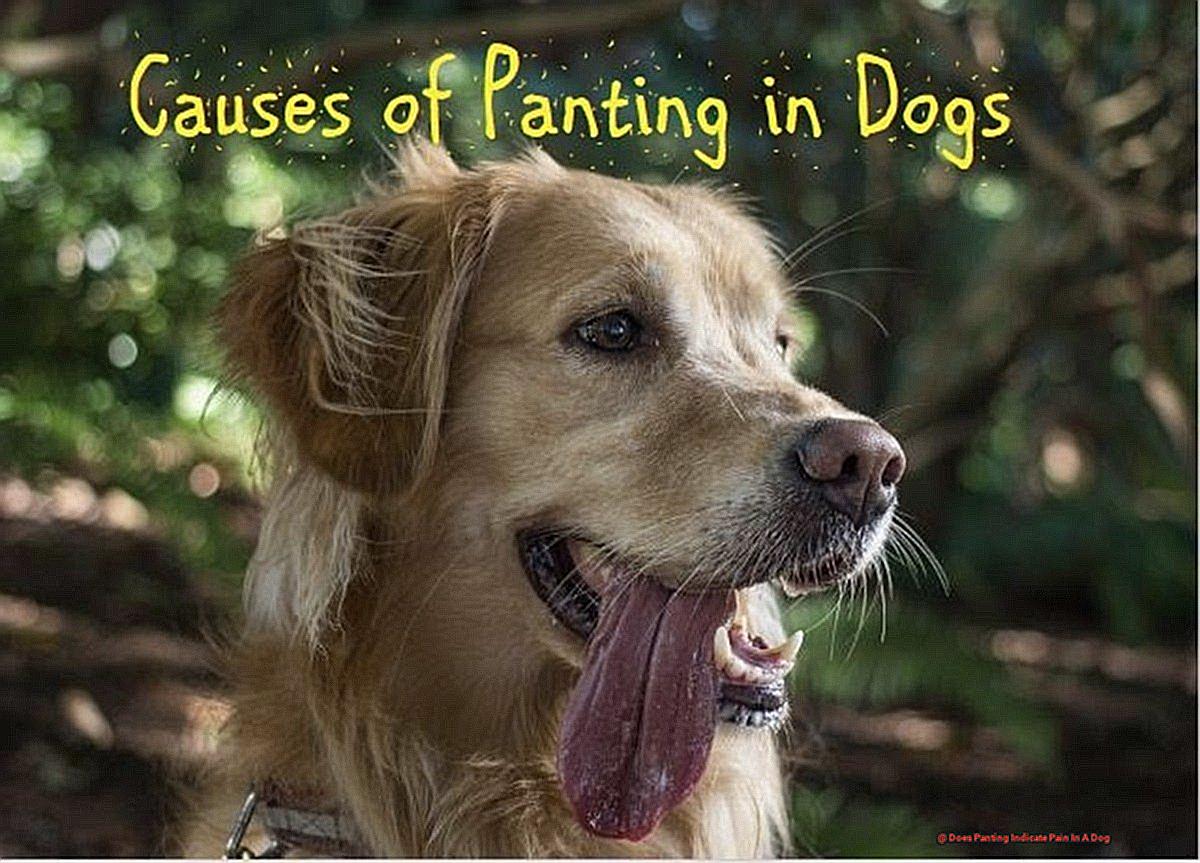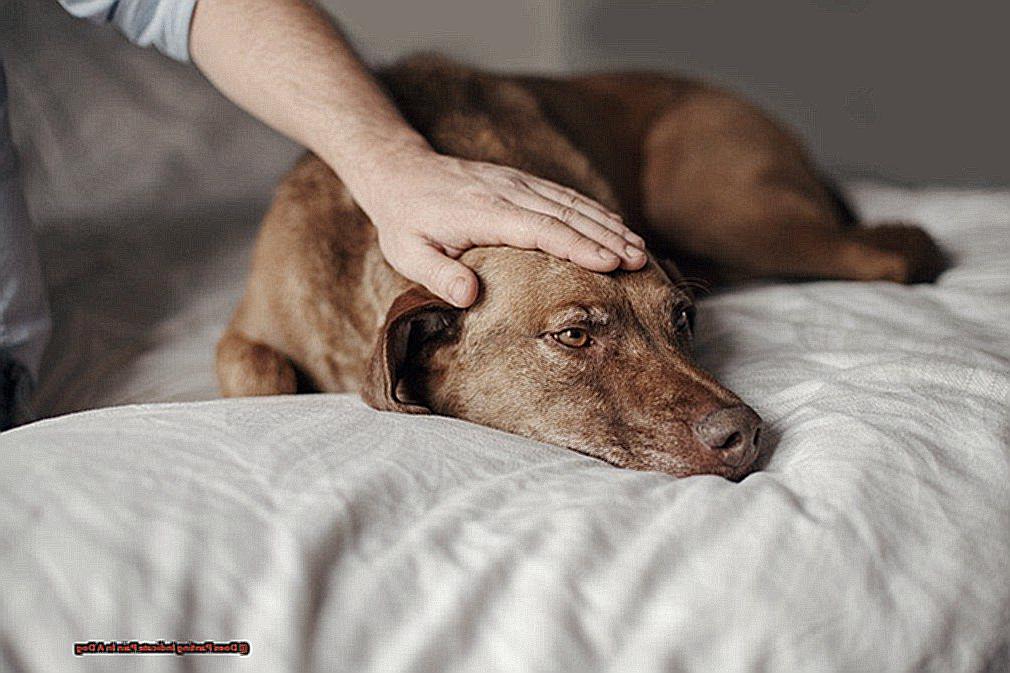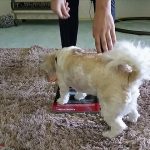Does Panting Indicate Pain In A Dog?
We all know that dogs have their own unique ways of communicating with us.
From wagging their tails to barking and whining, they use various forms of body language to convey their needs and emotions. But one behavior that often leaves us scratching our heads is panting.
As dog owners, we can’t help but wonder – is it a sign of pain in our furry friends? It’s natural to be concerned when our beloved pups start panting excessively.
Grab your favorite beverage, snuggle up with your pup, and let’s uncover the truth about panting in dogs.
Does Panting Indicate Pain In A Dog?
Contents
- 1 Does Panting Indicate Pain In A Dog?
- 2 Normal reasons for panting in dogs
- 3 When does panting indicate pain in a dog?
- 4 How to observe and interpret your dog’s panting
- 4.1 First, it is crucial to understand your dog’s normal panting patterns. Every dog is different, but typically, dogs pant when they are hot or after physical activity. However, if you notice that your French Bulldog is panting more frequently or for longer periods of time than usual, it could be a sign of pain.
- 4.2 It is also essential to keep track of any triggers that may cause your dog to start panting. For example, certain movements or activities may aggravate a specific area of pain in your dog’s body. This can help determine if there is a specific source of discomfort.
- 4.3 However, it is crucial to remember that every dog is different and may show different signs of pain. Therefore, it is essential to know your dog’s normal behavior and be aware of any changes that may indicate they are experiencing pain. Additionally, certain breeds, like French Bulldogs, may pant more than others due to their anatomy, so it is important to be aware of your dog’s breed tendencies.
- 5 Other signs of pain in dogs
- 6 Medical conditions that can cause excessive panting
- 7 Special considerations for French Bulldogs and panting
- 8 Conclusion
As pet owners, we always want our furry friends to be happy and healthy. So when we see them panting excessively, it can be concerning, especially for French Bulldog owners. With their adorable short snouts, these lovable pups may have a harder time breathing, making it difficult to determine if their panting is due to pain or just a normal behavior.
As an expert on this topic, I have researched and observed the connection between excessive panting and pain in French Bulldogs, and I’m here to share my insights with you.
Panting is a natural behavior in dogs and is often associated with excitement, anxiety, or heat. However, it can also be a sign of pain in dogs. This is because like us humans, dogs also have a fight or flight response to pain. They may pant as a way to cope with the discomfort and try to calm themselves down. In French Bulldogs, this can be particularly tricky as their short snouts make it challenging for them to breathe properly. Therefore, it is crucial for pet owners to pay close attention to their dog’s panting behavior.
So how can you tell if your French Bulldog’s panting is due to pain? Here are some key factors to consider:
- Location of the panting: If your dog is panting from their mouth only, it could be a sign of respiratory issues such as difficulty breathing or lung problems. However, if they are panting from both their mouth and nose, it could indicate pain in their chest or abdominal areas. In French Bulldogs, this could be caused by conditions like bloat or gastrointestinal issues.
- Accompanying signs: Dogs may also show other signs of pain along with excessive panting. These may include restlessness, whimpering, changes in behavior or appetite, and reluctance to move or be touched. If you notice any of these signs, it is essential to consult a veterinarian.
- External factors: It is crucial to consider any external factors that may be causing your dog to pant, such as heat or exercise. If your dog has been playing or running around in hot weather, it is normal for them to pant to regulate their body temperature. However, if there are no apparent external factors and your dog is still panting excessively, it could be a sign of pain.
Normal reasons for panting in dogs
French Bulldogs are known for their adorable wrinkled faces and loving personalities. However, as a proud owner of one of these lovable pups, you may have noticed that they pant more frequently compared to other breeds. This can be concerning for pet owners, but the good news is that panting is a natural behavior in dogs and serves an important purpose in their overall health and well-being.
So, why do French Bulldogs (and all dogs) pant? Let’s dive into the normal reasons for this behavior and how it can help us better understand our furry friends.
Regulating Body Temperature
Unlike humans, dogs do not have sweat glands all over their bodies to help them cool down. Instead, they rely on panting to regulate their body temperature when they are feeling hot or overheated. This is especially important for French Bulldogs, who are prone to overheating due to their thick coats and short snouts. So, if you see your Frenchie panting after a long walk or on a hot day, know that it’s their way of cooling off and is completely normal.
Response to Excitement or Stress
Just like us, dogs can also pant when they are feeling excited or stressed. This type of panting is usually short-lived and will subside once the dog has calmed down. So, if your French Bulldog starts panting when you come home or when they see their favorite toy, it’s a sign that they are happy and excited.
Post-Exercise Recovery
After a bout of physical activity, you may notice your French Bulldog panting heavily. This is because panting helps them catch their breath and regulate their body temperature after exercising. However, if your dog continues to pant heavily even after resting, it could be a sign of an underlying issue and should be checked by a veterinarian.
Pain or Discomfort
One of the most concerning reasons for panting in dogs is due to pain or discomfort. If your French Bulldog is experiencing pain, they may pant as a way to cope with the discomfort. This can be a sign of various health issues such as injuries, arthritis, dental problems, and gastrointestinal problems. If you notice your dog panting differently than usual, it’s best to consult with your veterinarian for proper diagnosis and treatment.
When does panting indicate pain in a dog?
While panting is a common behavior in dogs, it can also be a sign of pain. In this section, we’ll dive into the topic of when panting indicates pain in dogs, and why it’s crucial for pet owners to be aware of their pet’s typical behavior.
Understanding the Reasons Behind Panting
Panting is a natural way for dogs to regulate their body temperature and cool down. It’s also a common response to excitement or exertion. However, when a dog is experiencing pain, their body goes into a fight or flight response, causing them to pant heavily. This is because panting helps to provide more oxygen to their muscles and regulate their body temperature during times of stress or potential danger.
Distinguishing Between Normal and Pain-Related Panting
It’s important to note that not all panting indicates pain in dogs. Some breeds, such as French Bulldogs, are prone to panting due to their shortened skull shape, which can make it challenging for them to breathe normally. In these cases, panting is not a reliable indicator of pain.
So how can we determine if our dog’s panting is a sign of pain? As responsible pet owners, it’s crucial to observe our dogs’ overall behavior and body language. If they seem lethargic, avoid activities they usually enjoy, or have a tense posture, these could be indications that they are in pain.
Other physical signs that may accompany panting in a dog experiencing pain include whining or whimpering, restlessness, excessive grooming or licking at a specific area, and changes in appetite or bathroom habits. These behaviors can vary depending on the individual dog and the severity of their pain.
The Importance of Knowing Your Dog’s Typical Behavior
As mentioned earlier, not all panting in dogs indicates pain. That’s why it’s crucial for dog owners to know their pet’s typical behavior and habits. By being aware of your dog’s usual demeanor, you can easily spot any changes that may indicate pain. This includes being knowledgeable about any recent injuries or illnesses that could be causing discomfort for your furry friend.
How to observe and interpret your dog’s panting
As pet owners, we want to ensure that our furry friends are happy and healthy at all times. So, when we notice our beloved French Bulldogs panting excessively, it can be concerning. While panting is a natural behavior in dogs, it can also be a sign of pain or discomfort. As an expert on dog behavior, I have put together a guide for owners of French Bulldogs on how to determine if their pet’s panting may be a sign of pain.
First, it is crucial to understand your dog’s normal panting patterns. Every dog is different, but typically, dogs pant when they are hot or after physical activity. However, if you notice that your French Bulldog is panting more frequently or for longer periods of time than usual, it could be a sign of pain.
Next, pay attention to the intensity of your dog’s panting. If it sounds louder or more labored than usual, it could indicate that they are in discomfort. It is also essential to consider the environment and temperature. Dogs may pant more when they are hot or after exercise, but if they continue to pant excessively even in cool environments, it could be a sign of pain.
It is also essential to keep track of any triggers that may cause your dog to start panting. For example, certain movements or activities may aggravate a specific area of pain in your dog’s body. This can help determine if there is a specific source of discomfort.
Aside from observing your dog’s panting behavior, there are other signs that may indicate pain. These include limping, reluctance to move, whining, changes in behavior or appetite, and posture while panting (hunched over or lying down).
However, it is crucial to remember that every dog is different and may show different signs of pain. Therefore, it is essential to know your dog’s normal behavior and be aware of any changes that may indicate they are experiencing pain. Additionally, certain breeds, like French Bulldogs, may pant more than others due to their anatomy, so it is important to be aware of your dog’s breed tendencies.
If you suspect that your French Bulldog’s panting is due to pain, it is crucial to consult with a veterinarian immediately. Ignoring signs of pain can lead to more serious health issues for your furry friend. Your veterinarian can provide professional guidance and evaluate your dog’s overall health.
Other signs of pain in dogs
While panting can be an obvious indicator, there are several other signs that you should look out for. As an expert on this topic, I have compiled a list of common indicators of pain in dogs to help you ensure your pet’s health and well-being.
Changes in behavior are often the first sign that something is wrong with your dog. If they become withdrawn, avoid physical activity, or show signs of aggression, it could be a sign of pain. It’s crucial to observe any changes in their routine and note if they seem restless or unable to settle down.
Another common sign is a loss of appetite. Just like humans, dogs may lose interest in food when they are feeling unwell. If your French Bulldog suddenly stops eating or shows disinterest in their food, it could be a red flag for pain or discomfort.
Limping or difficulty moving around can also indicate pain in dogs. This could be caused by joint problems, injuries, or other underlying health issues. If you notice your Frenchie limping or having trouble getting up and down, it’s essential to take them to the vet for further examination.
Excessive grooming is another sign to watch out for. While dogs groom themselves when they’re anxious or stressed, excessive licking or chewing on a particular area of their body could indicate pain. This behavior could also lead to skin irritation and hot spots, so it’s crucial to address it early on.
Changes in sleeping habits can also be a sign of pain in dogs. Your Frenchie may have trouble finding a comfortable position to sleep in or wake up frequently during the night. Watch out for any changes in their sleeping patterns and consult with your vet if necessary.
Just like howling can indicate discomfort in wolves, whining or crying can be a sign of pain in dogs. Pay attention to your dog’s vocalizations, and observe if they seem to be coming from a particular area of their body. This can help you pinpoint the source of their pain.
Lastly, changes in posture can also indicate pain in dogs. They may keep their head down, tuck their tail between their legs, or hunch over, trying to protect a particular part of their body. Regularly observing your Frenchie’s posture can help you identify any potential issues.
Medical conditions that can cause excessive panting
While panting is a normal behavior for dogs, excessive or unusual panting can indicate an underlying medical condition that requires proper treatment. As a responsible dog owner, it is important to understand the various medical conditions that can cause this symptom in order to address your dog’s discomfort and ensure their overall well-being.
Heat stroke is one common cause of excessive panting in dogs. This occurs when a dog’s body temperature rises to dangerous levels, often due to being in a hot environment or engaging in strenuous activity. Panting is a dog’s way of regulating their body temperature, so excessive panting can indicate that they are struggling to cool down and may be experiencing pain or discomfort.
Another potential cause of excessive panting is respiratory issues such as asthma, allergies, or infections. These conditions can cause breathing difficulties in dogs, leading to panting as they try to take in more oxygen. If your dog is panting excessively and also has trouble breathing, it could be a sign of an underlying medical condition that requires treatment.
Dogs with heart problems may also experience excessive panting. This can be due to their heart struggling to pump enough blood and oxygen throughout the body, making it difficult for them to catch their breath. In addition to panting, other symptoms such as coughing, weakness, and loss of appetite may also be present.

Abdominal pain is another potential cause of excessive panting in dogs. This can be caused by various issues such as stomach ulcers, pancreatitis, or bloat. Dogs experiencing abdominal pain may pant excessively as well as show signs of discomfort such as restlessness, lethargy, and lack of appetite. It is important to seek veterinary care if you suspect your dog is experiencing abdominal pain.
In some cases, panting may also indicate a neurological issue in dogs. For example, seizures can cause excessive panting and should be addressed by a veterinarian immediately. Additionally, dogs with brain tumors may also experience excessive panting as a result of the pressure on their brain.
Special considerations for French Bulldogs and panting
Let’s dive into these special considerations for our beloved Frenchies.
First things first, let’s talk about their cute little faces. French Bulldogs have a brachycephalic facial structure, which simply means they have a short nose and flat face. While this may add to their charm, it also makes it difficult for them to breathe normally. This is why you may notice your Frenchie panting more often than other breeds. But don’t worry, this is completely normal and just their way of cooling down.
On that note, French Bulldogs are also known for their tendency to overheat easily. With their thick coat and short snout, they are more susceptible to heatstroke. This is why it is crucial to provide them with ample shade and water during hot weather. So, if you see your Frenchie panting excessively while out on a walk or playing in the sun, it’s time for a cool break.
But what about when panting is not just a way to regulate body temperature? As mentioned earlier, panting can also be a sign of discomfort or pain. Unfortunately, French Bulldogs are prone to certain health conditions that can cause pain and difficulty in breathing. Joint problems like hip dysplasia and intervertebral disc disease (IVDD) are common in this breed and can lead to excessive panting. If your Frenchie is experiencing these issues, it’s important to consult with a veterinarian for proper management and treatment.
Let’s not forget about allergies. Just like us humans, our furry friends can also have allergies that can manifest in various ways. For French Bulldogs, this can mean skin irritation, respiratory issues, and inflamed airways. In these cases, panting may be a sign of discomfort and it’s best to consult with a vet for proper diagnosis and treatment.
Also Read: Can French Bulldogs Eat Skippy Peanut Butter
Conclusion
In conclusion, as responsible dog owners, it is our duty to ensure the well-being of our beloved furry companions. And when it comes to their health, one behavior that often leaves us perplexed is panting. But fear not, we have delved deep into the subject and revealed the truth about panting in dogs and its correlation with pain.
By familiarizing ourselves with our dog’s normal behaviors and paying close attention to any changes, we can better determine if they are experiencing discomfort or pain. It is also important to consider external factors such as weather and physical activity levels. And when in doubt, seeking professional help from a veterinarian is always the best course of action.
For those who own French Bulldogs, there are some special considerations to keep in mind due to their unique facial structure and tendency to overheat easily. Knowing these factors can help us better understand our Frenchie’s panting patterns and potential sources of discomfort.
Remember, being knowledgeable about our pets’ typical behaviors and seeking proper medical care when needed is crucial for ensuring their happiness and well-being.




